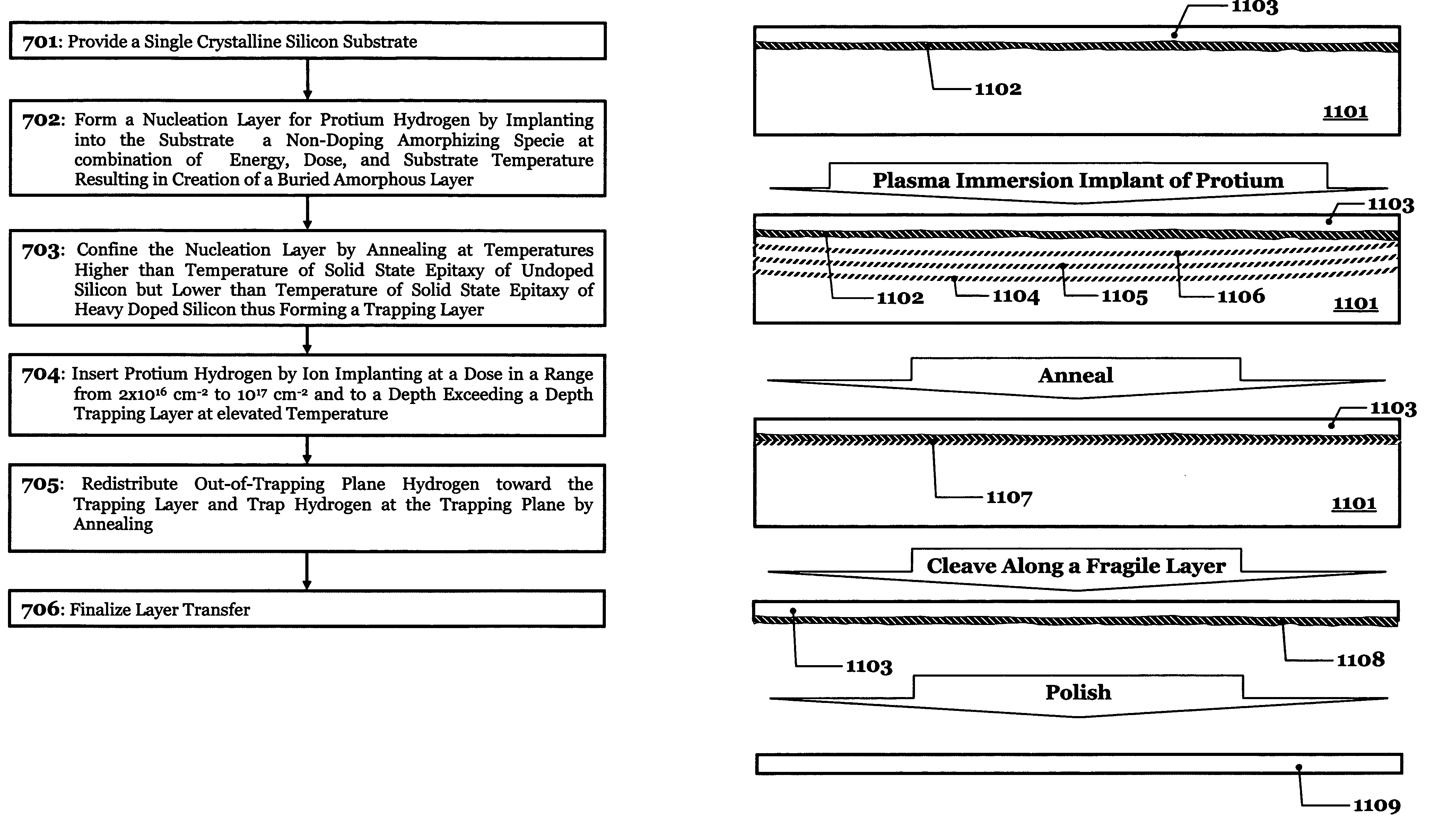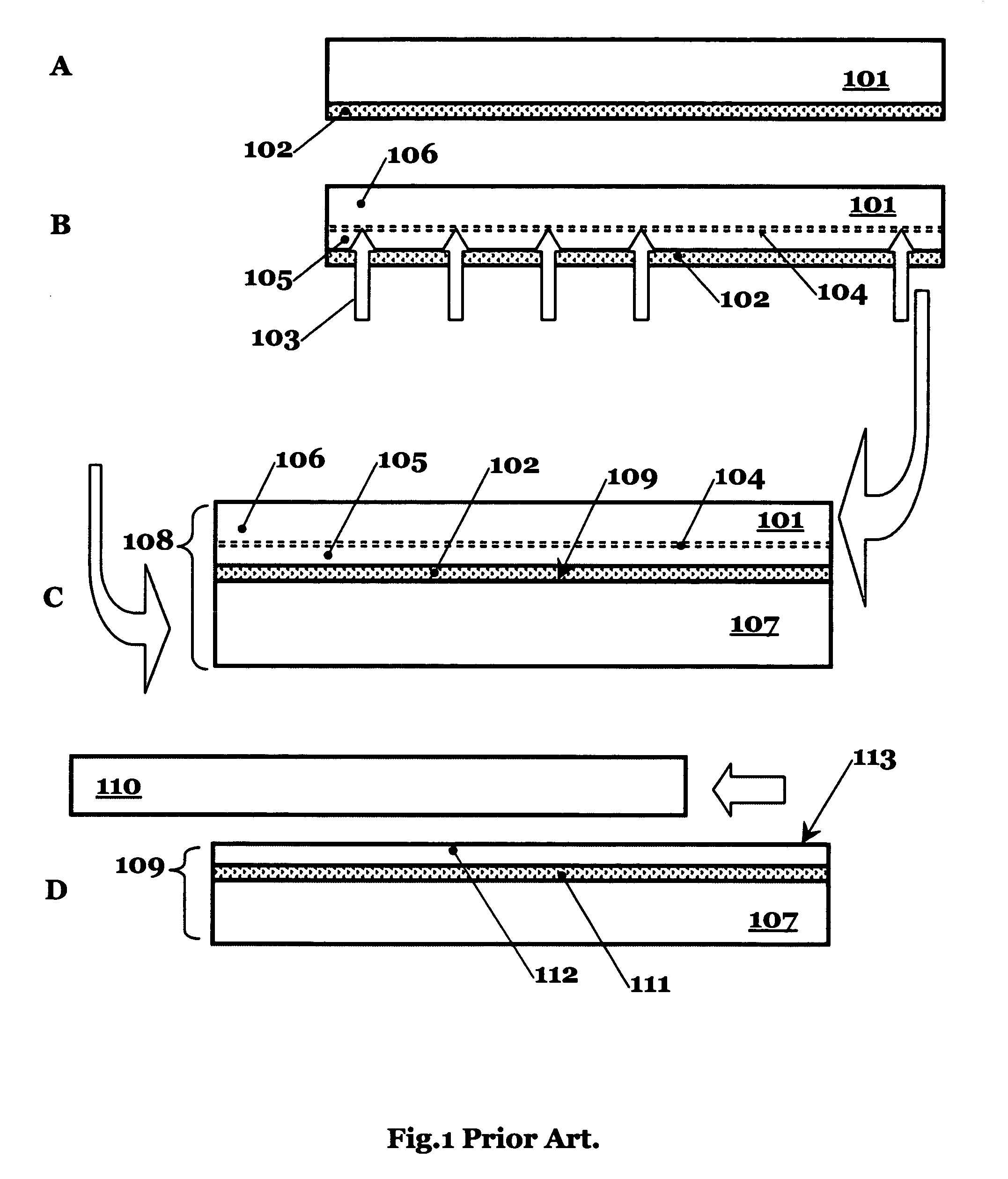The most important drawbacks of the Smart-
Cut are as follows:(1) difficult to get thin transferred layer;(2) high manufacturing cost.
The difficulty in the transfer of thinner
layers in the Smart-
Cut is caused by the use of hydrogen implantation into plain silicon lattice.
Chip manufacturing, however, requires much thinner superficial silicon, and insulator layer thicknesses.
Smart-
cut however, is limited to layer transfers in excess of 200 nm.
At lower energies, Smart-
Cut process fails.
This results in quite narrow peak of distribution of
high energy ions.
The diffused profile causes the Smart-Cur failure.
Another reason why Smart-Cut fails to transfer thin films relates to surface damage by sub-20 keV ions.
Without bonding, the layer cannot be transferred, and Smart-Cut fails.
Another cause why Smart-Cut fails to transfer thin films is a premature blistering of wafer surface if the wafer is implanted with low energy ions.
Low energy implantation results in shallow location of the bubbles.
Thinning however increases thickness non-uniformity of the superficial crystalline film of SOI wafer that is highly undesirable.
High manufacturing costs of the Smart-Cut are caused by necessity of prolonged hydrogen implanting.
Hydrogen implantation in Smart-Cut cannot however benefit from high
ion beam current.
If the target (i.e, silicon wafer) is heated over about 80° C. during the implantation, Smart-Cut fails.
Heating of the wafer under implantation causes premature blistering.
Therefore the best achievable
throughput in the Smart-Cut is limited to about 10 wph (wafers per hour).
This is not enough to achieve a cost-efficient SOI wafer production.
The direct replacement of the beam implantation by
plasma immersion in the Smart-Cut results, however, in much worse quality of final SOI wafers.
A crystalline quality of that heavily hydrogenated silicon cannot be healed by annealing to a level required by
chip production.
Some of them works as infinite traps for hydrogen; and the higher
dose hydrogen implantation, the bigger amount of hydrogen platelets and bubbles will be created on these unintentional and unavoidable traps.
The hydrogen platelets and the bubbles are non-point defects, and silicon that contains these features cannot be annealed to restore its initial perfect lattice.
Finally,
plasma immersion implantation version of the Smart-Cut results in SOI wafers with low quality superficial silicon.
Another problem with Henley's process is that it results in thinner transferred
layers at wafer periphery as compared to the wafer center.
Fan et al. in Z. Fan, P. K. Chu, N. W. Cheung, C. Chan, Thickness uniformity of silicon-on-insulator fabricated by
plasma immersion
ion implantation and ion
cut, IEEE Transactions on
Plasma Science, Vol. 27, 1999, pages 633–636 given an experimental evidence of thickness non-uniformity of the plasma immersion implantation version of the Smart-Cut; the thickness non-uniformity is a serious quality problem in the final SOI wafer.
These Smart-Cut improvements either partially resolve the thickness and cost related Smart-Cut issues, or create quality issues.
Agarwal's approach, however, does not solve the thickness problems of the Smart-Cut.
Subsequently, the thickness limitation is the same as in the Smart-Cut, and thin transfers are not enabled by Goesele.
Therefore the
throughput problem is not solved by Goesele either.
We believe that Bower's process cannot enable the ultrathin transfers.
Due to Bower's teaching, annealing of the
boron-implanted wafer result in complete removal of implantation damages and in electrical activation of
boron.
This says that sub-100-nm layer transfers will be extremely non-uniform in thickness, and thus are not technically featurable for thin SOI production.
Another reason, why Bower's teaching cannot be applied for manufacturing of thin SOI relates to unwanted altering of electrical properties of the transferred silicon layer.
Chips cannot be manufactured in these heavy doped films for several reasons, for example, because carrier mobility drastically drops in heavy doped semiconductors, and also because a depleted zone will not extend through entire thickness of silicon film, so fully depleted devices cannot be manufactured.
This process is free from limitations inherent to Smart-Cut
cut process as relative to thickness and to
implant-related cost, but it is more difficult to get high quality SOI wafers using the U.S. Pat. No. 6,352,909 process.
The quality problems appear in both, electrolytic, and plasma methods of hydrogenation.
The
etching preferentially proceeds on defected surface areas, therefore the
etching is not area-uniform, and roughness of silicon wafer surface increases.
The
rough surface wafer is difficult to bond to a destination wafer.
The roughness causes bonding voids between the wafers.
The voids cause layer transfer faults, and a final SOI wafer has areas with missing superficial silicon.
These wafers are rejected and are not useful anymore.
 Login to View More
Login to View More  Login to View More
Login to View More 


